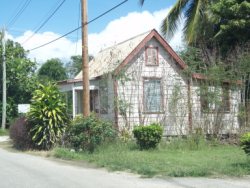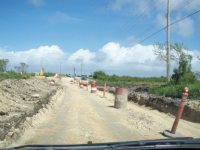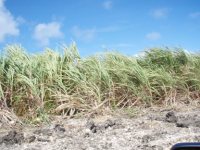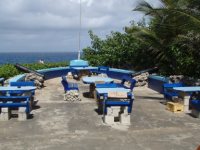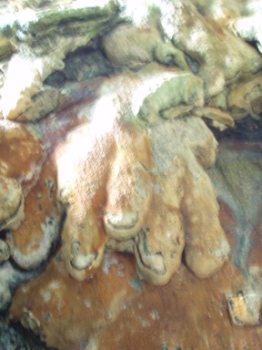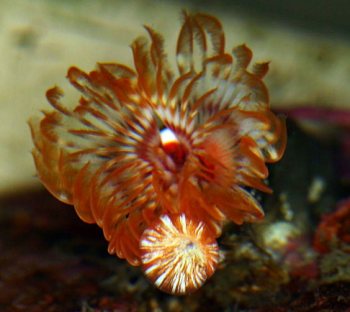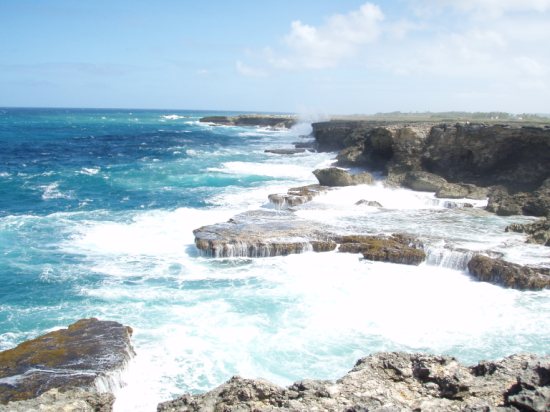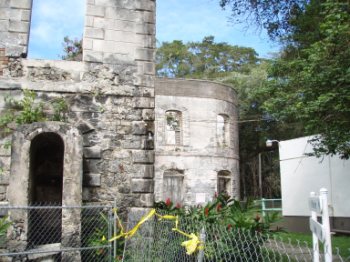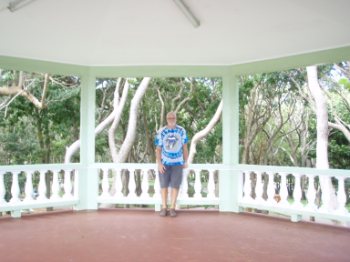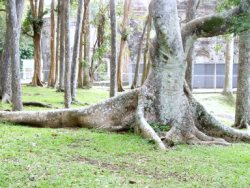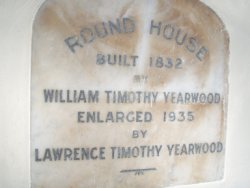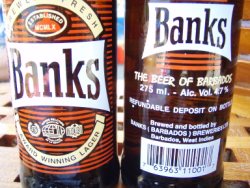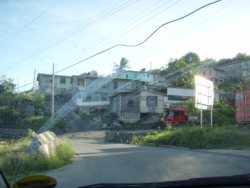Day 1 Barbados

|
Day 1 - Hire Car - Barbados
We decided to hire a car for a few days to explore the island, much cheaper than by touring taxi and less damaging to health than the buses. We took the map and divided it into three and off we went toward the first chunk. We set off northward toward Crab Hill, the hire car man said “nothing there” but I wanted to go as I have my ‘thing’ about crabs.
Chattel houses we saw en route and a Cattle Egret off for a stroll. Crab Hill is a settlement at the northern end of the parish of Saint Lucy. The place was so named because large numbers of crabs would appear in the area during rainfall; people would catch the crabs and keep them as pets. The Mount Gay North Stars cricket grounds are located in here. We disturbed many cricket games as we drove along when the stumps had to be moved from the centre of the road, to let us through.
We encountered some spectacular road works, pot-holes and road slip on our journey. Miles of sugar cane. Cows with Ibex always nearby to pick off the flies and mites. Entering Crab Hill and the sign. Then we set off toward the animal flower cave, as we turned left a chap jumped out in front of us, Adrian, wanting us to see his stall. We bought a little wooden map to hang below our Lanzarote tile on Beez.
Bear and Adrian, not what I would have thought to see in a remote bar - a fully loaded soldier, but he had a lovely bottom. The inside of the bar was covered in business cards, caps and flags. Bear and the soldier - I got to compare rear ends, cheeky. We could not sit outside because the chairs and tables had just been repainted.
The Animal Flower Cave is located at the most northerly point of Barbados in the parish of St. Lucy. The name "Animal Flower Cave" comes from the sea anemones found in the pools of the cave. Some of these pools have hundreds of crabs and sea-anemones.There are also several openings looking out to sea, offering some spectacular views The now famous cave has been featured in singer Billy Ocean's music videos and in the soap opera "Bold and Beautiful". The first photo show what the locals call "The Hand of God" that they say "holds up the entire hillside". Angel Flower Cave. One of the tubeworms that give it its name.
St. Nicholas Abbey , located in the parish of St. Peter, was built in 1660 and is one of only three genuine Jacobean mansions in the Western Hemisphere. Barbados is home to two of these mansions St. Nicholas Abbey and Drax Hall. Distinguishing features of this magnificent, well-preserved mansion are: curved Dutch gables, chimney stacks and coral stone finials, a Chinese Chippendale staircase and fine antiques and china. A rare 1930s film of sugar plantation life can also be viewed. St. Nicholas Abbey is not without its tale of tragedy. The house appears to have been built by Colonel Benjamin Berringer. His neighbour, friend and business partner was John (later Sir John) Yeamans. When Yeamans began to pay attention to Mrs. Berringer, a feud erupted between the two men, culminating in a duel in which Berringer was killed. Soon afterwards, Sir John married Mrs. Berringer and claimed the Abbey. A court ruling later returned the property to Berringer's children and the property was named after Berringer's grand-daughter who married George Nicholas.Meanwhile, Sir John and Berringer's widow left Barbados in 1669 and helped found the colony that is South Carolina, USA, with Sir John eventually becoming Governor of that settlement in 1672. When he died two years later, his widow married again for the third time.
St Nicholas Abbey.
Cherry Tree Hill. Approximately 850 feet above sea level, this area offers an excellent view of the “Scotland District”. The area is named after a Patron Saint of Scotland and completely covers the parish of St. Andrew. It is believed that the name “Cherry Tree Hill” originated from the large number of cherry trees, which once existed there. Today the road is lined by mature mahogany trees, which were introduced to Barbados after the Treaty of Paris in 1763.
Farley Hill National Park. Breathtaking scenery, set in the grounds of the once regal Farley Hill House. A mansion in ruins, tucked away in a forest of mahogany trees, high up on a hill overlooking the rugged Atlantic coast. Farley Hill is an idea spot to picnic, escape into nature, hide in the shade of a comforting tree and to simply stare out to sea. It is also a spot favoured by visitors for getting married .
Farley Hill House became regarded as the most impressive mansion in Barbados. The earliest part of the house - originally known as Grenade Hall - is thought to have been built in 1818. It was initially owned by Joseph Lyder Briggs in 1850, who in turn gave it to his son Thomas Graham Briggs in 1856. In 1857, after his marriage, Graham Briggs added the south wing, the library, dining room along with a billiard room and bedrooms and then re-named it Farley Hill. Sir Graham Briggs was a wealthy British planter and legislator, he improved not only the house, but also the gardens, importing many new plants and trees to the island. After the death of Mr. Briggs, the house was given to his brother-in-law, Mr. Benjamin Courbank Howell, and for almost half a century, the Howell family lived here. When the family moved from Farley Hill, the property was rented at $25 per month, and then it remain empty. In 1940, it was sold to Mr. W. W. Bradshaw, but it was in such a state of decay, that it could only serve as a weekend resort. In 1956, Farley Hill was partially restored to its former splendour for some of the sequences in the film: Island in the Sun.
Large quantities of wood and other inflammable material were used for the restoration, and a few years later, fire destroyed everything, but the walls. In 1965, the Government of the day, headed by the Rt. Hon. E. W. Barrow, recognised the importance of preserving features of historical interest, and purchased the property and declared it a national park. Farley Hill was officially opened as a national park by HM Queen Elizabeth II in 1966, the same year Barbados gained independence. Several times a year Farley Hill is transformed into a stage for musical and theatrical events. The Barbados Jazz Festival, a week long festival featuring the worlds leading jazz musicians, stages a remarkable one day open air concert in the park each January. On this day the magnificent ruins of Farley Hill House become the background for a stage. Picnic baskets are opened under the tall mahoganies and all ages and all nations dance, listen and enjoy superb music in an unforgettable atmosphere of joy, friendship and tranquility.
Today, even though the Farley Hill Great House is now a ruin, work is still being been done on the grounds. The saplings and dead trees were removed and a large lawn was developed, along with numerous flowering shrubs. The landscaping of the park is a never-ending process and this work continues on a daily basis. Adjoining the park, is a fine stand of woodland of about thirty acres, which is destined to host a wide variety of trees.
   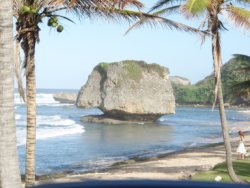
Bathsheba is the main fishing village in the parish of Saint Joseph with some 5,000 inhabitants on the eastern coastline. The town has a number of quaint churches; Saint Joseph Anglican Church was built on Horse Hill in the town as early as 1640 but was rebuilt in 1839 following a hurricane in 1831. Little Saint Joseph chapel was built nearby in 1837 but was restored and dedicated to Saint Aiden in 1904 following a landslide. It has a number of attractions including the Flower Forest and Cotton Tower which is renowned for its dramatic scenery and views of Scotland District. The ecologically rich Joe's River Tropical Rainforest is located on the outskirts of the town with some 85 acres (340,000 m2) of woodland and rainforest with giant ficus, citrifolia, fid woods, white woods, cabbage palm trees and mahogany trees. Bathsheba beach is known as the Soup Bowl where local and international surfing competitions take place annually. Another notable feature of Bathsheba beach is the large boulder that sits slightly offshore, known by some as Bathsheba Rock.
The hire car man told us to have our lunch at The Round House in Bathsheba on a bluff overlooking the sea. I had BLT and fries, glass of water and a white wine. Bear had Macoroni Pie, Asparagus Quiche and salad, washed down with a beer and a glass of water. It took ages for the sparrows to get brave enough to come and take scraps, not so the cocky Carib Grackle, who helped himself off Bears plate. The Round House. “With commanding views that rival any location in the world, we overlook“super bowl“, the premier surf location on the island, just a one minute walk to the beach. There are tidal pools directly in front of our in. Full swimming access is available within a five minute walk to our north or south, which covers a nine mile beach stretch on which you will see only a handful of people. Please be cautious when swimming, as the east cost can be rough at times.
Round House was built in 1832, and has been meticulously restored by the present owners. Round House consists of six guest rooms with private bath, sky-lights, roof decks and panoramic views. Round House serves breakfast, lunch and dinner six days a week, breakfast and lunch on Sundays“. Room Rates $85 -160 US +7.5% tax and food on top. What the blurb does not say is that the surf and undertow directly in front is deadly.
The local beer, Martins Bay, Walkers town which overlooks Walker's Savannah and beach and the supermarket. We drove past Martin’s Bay and headed back via Bridgetown to find a big supermarket within an out of town mall. Some prices DO make your eyes water. I am used to my treat of a kilo of cherries whenever we were in N. France, here 7 cherries in a Styrofoam pack cost £3. Tinned tomatoes at £2, tinned sliced mushrooms £3. Fruit and veg brought in from the US is painfully expensive, local odd shaped tomatoes were 7 Barbados Dollars, equally shaped plum tomatoes from US 17 Barbados Dollars. Exchange rate at the moment is 2.95 Barbados to the UK pound. There is a fixed rate with the US at 1.98.
ALL IN ALL a very good day out - a fascinating look into colonial history.
|
